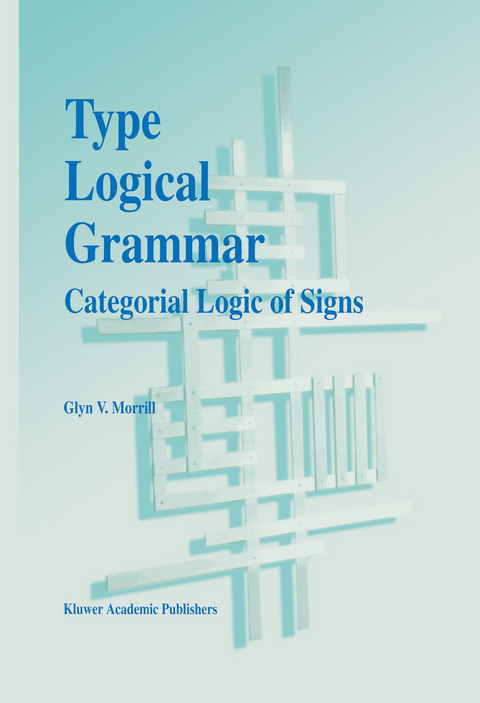
Type Logical Grammar
Categorial Logic of Signs
Seiten
1994
|
Softcover reprint of the original 1st ed. 1994
Springer (Verlag)
978-0-7923-3226-8 (ISBN)
Springer (Verlag)
978-0-7923-3226-8 (ISBN)
Sets out the foundations, methodology and practice of a formal framework for the description of language. The approach embraces the trends of lexicalism and compositional semantics in computational and theoretical linguistics by developing categorial grammar into a logic of signs.
This is not quite the book I originally intended to write. Since I first felt that linguistic application of categorial grammar merited a system- atic presentation, I have been subject to (what seemed to be) a series of demanding technical and foundational distractions. Inspite of a prej- udice that mathematical elegance was even inconsistent with linguistic practicality, repeated illumination of the latter by the former implied a new perspective on the field, one prompting formal innovation, and some re-examination of methods and goals. This piece collects and extends work over the last four years general- ising categorial grammar to a categorial logic. The state of the art at the beginning of that period was represented by the edited collections Oehrle, Bach and Wheeler (1988) and Buszkowski, Marciszewski and van Benthem (1988) (see Morrill 1991a, b), and by Moortgat (1988b). Familiarity with such work however is not strictly necessary for an un- derstanding of the present one, which attempts to map a self-contained, if intensive, course with Montague Grammar as its point of departure.
This being the case, the reader should have an understanding of logical semantics and its technicalities, such as would be obtained from Dowty, Wall and Peters (1981), or Gamut (1991). Some familiarity with the issues raised by contemporary syntactic theories would also be useful, as would some familiarity with logical deduction.
This is not quite the book I originally intended to write. Since I first felt that linguistic application of categorial grammar merited a system- atic presentation, I have been subject to (what seemed to be) a series of demanding technical and foundational distractions. Inspite of a prej- udice that mathematical elegance was even inconsistent with linguistic practicality, repeated illumination of the latter by the former implied a new perspective on the field, one prompting formal innovation, and some re-examination of methods and goals. This piece collects and extends work over the last four years general- ising categorial grammar to a categorial logic. The state of the art at the beginning of that period was represented by the edited collections Oehrle, Bach and Wheeler (1988) and Buszkowski, Marciszewski and van Benthem (1988) (see Morrill 1991a, b), and by Moortgat (1988b). Familiarity with such work however is not strictly necessary for an un- derstanding of the present one, which attempts to map a self-contained, if intensive, course with Montague Grammar as its point of departure.
This being the case, the reader should have an understanding of logical semantics and its technicalities, such as would be obtained from Dowty, Wall and Peters (1981), or Gamut (1991). Some familiarity with the issues raised by contemporary syntactic theories would also be useful, as would some familiarity with logical deduction.
One: Montague Grammar.- Two: Logic of Types and Types of Logic.- Three: Categorial Grammar.- Four: Enriching Categorial Grammar.- Five: Intensionality and Binding.- Six: Polymorphism.- Seven: Structural Control.- Eight: Extraction.- Nine: Conclusion.- Appendix A: Interpretation of Types.- Appendix B: Gentzen Sequent Rules.- Appendix C: Summary Grammar.
| Zusatzinfo | XIV, 307 p. |
|---|---|
| Verlagsort | Dordrecht |
| Sprache | englisch |
| Maße | 152 x 223 mm |
| Themenwelt | Geisteswissenschaften ► Philosophie ► Allgemeines / Lexika |
| Geisteswissenschaften ► Philosophie ► Logik | |
| Geisteswissenschaften ► Sprach- / Literaturwissenschaft ► Sprachwissenschaft | |
| Informatik ► Theorie / Studium ► Künstliche Intelligenz / Robotik | |
| ISBN-10 | 0-7923-3226-1 / 0792332261 |
| ISBN-13 | 978-0-7923-3226-8 / 9780792332268 |
| Zustand | Neuware |
| Haben Sie eine Frage zum Produkt? |
Mehr entdecken
aus dem Bereich
aus dem Bereich
Buch | Softcover (2024)
REDLINE (Verlag)
20,00 €
Eine kurze Geschichte der Informationsnetzwerke von der Steinzeit bis …
Buch | Hardcover (2024)
Penguin (Verlag)
28,00 €


